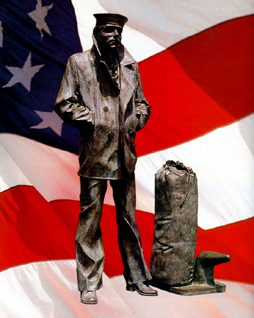DEASON-WILLIAM
WILLIAM RAY "RAY" DEASON

AD

USS Lexington (CV/CVA/CVS/CVT/AVT-16), nicknamed "The Blue Ghost", is an Essex-class aircraft carrier built duringWorld War II for the United States Navy. Originally intended to be named Cabot, word arrived during construction that theUSS Lexington (CV-2) had been lost in the Battle of the Coral Sea. She was renamed while under construction to commemorate the earlier ship.[4] She was the fifth US Navy ship to bear the name in honor of the Revolutionary War Battle of Lexington.
Lexington was commissioned in February 1943 and saw extensive service through the Pacific War. For much of her service, she acted as the flagship for Admiral Marc Mitscher, and led the Fast Carrier Task Force through their battles across the Pacific. She was the recipient of 11 battle stars and the Presidential Unit Citation. Following the war, Lexington was decommissioned, but was modernized and reactivated in the early 1950s, being reclassified as an attack carrier (CVA). Later, she was reclassified as an anti-submarine carrier (CVS). In her second career, she operated both in the Atlantic/Mediterranean and the Pacific, but spent most of her time, nearly 30 years, on the east coast as a training carrier (CVT).
Lexington was decommissioned in 1991, with an active service life longer than any other Essex-class ship. Following her decommissioning, she was donated for use as a museum ship in Corpus Christi, Texas. In 2003, Lexington was designated aNational Historic Landmark. Though her surviving sister ships Yorktown, Intrepid, and Hornet carry lower hull numbers,Lexington was laid down and commissioned earlier, making Lexington the oldest remaining fleet carrier in the world.
Far East
Lexington's next Far Eastern tour began late in 1960, and was extended well into 1961 by renewed tension in Laos. Returning to west coast operations, she was ordered in January 1962 to prepare to relieve Antietam as aviation training carrier in the Gulf of Mexico, and she was redesignated CVS-16 on 1 October 1962. However, during the Cuban missile crisis, she resumed duty as an attack carrier, and it was not until 29 December 1962 that she relieved Antietam at Pensacola, Florida.
Training carrier
Into 1969, Lexington operated out of her home port, Pensacola, as well as Corpus Christi and New Orleans, qualifying student aviators and maintaining the high state of training of both active duty and reserve naval aviators. Her work became of increasing significance as she prepared the men vital to the Navy and Marine Corps operations overVietnam, where naval aviation played a major role. Lexington marked her 200,000th arrested landing on 17 October 1967, and was redesignated CVT-16 on 1 January 1969. She continued as a training carrier for the next 22 years until decommissioned and struck on 8 November 1991.
In 1980, Lexington became the first aircraft carrier in US Naval history to have women stationed aboard as crew members (18 Aug. 1980).[13]
On 29 October 1989, a student Naval Aviator lost control of his T-2 training aircraft after an aborted attempt to land on Lexington's flight deck. The aircraft impacted the island with its right wing, killing four crew members (including the pilot of the plane) and one civilian maintenance worker[14] and injuring seventeen.[15] The island suffered no major damage, and fires from the burning fuel were extinguished within 15 minutes.[16][17]
Lexington was the final Essex-class carrier in commission, after Oriskany had been decommissioned in 1976.

